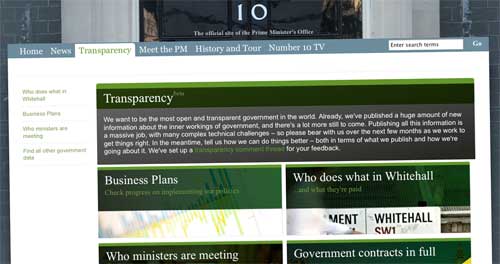
Martha Lane Fox’s review of Directgov has been published this morning – as an 11 page, 5.7MB graphic-based PDF file, making it impossible to search or select text. (Thanks to various colleagues on Twitter for confirming it wasn’t just me.) Its key recommendations, pretty much as anticipated:
- Make Directgov the government front end for all departments’ transactional online services to citizens and business, with the teeth to mandate cross government solutions, set standards and force departments to improve citizens’ experience of key transactions.
- Make Directgov a wholesaler as well as the retail shop front for government services & content by mandating the development and opening up of Application Programme Interfaces (APIs) to third parties.
- Change the model of government online publishing, by putting a new central team in Cabinet Office in absolute control of the overall user experience across all digital channels, commissioning all government online information from other departments.
- Appoint a new CEO for Digital in the Cabinet Office with absolute authority over the user experience across all government online services (websites and APIs) and the power to direct all government online spending.
The document is entitled ‘Revolution not evolution’ – but that’s certainly not the tone of the Cabinet Office press release, which describes the proposals in the most anodyne form imaginable. Where Martha talks about recruiting a ‘CEO for Digital’, and giving him/her ‘absolute’ power, the press release talks about an ‘Executive Director’ – note the immediate switch to Civil Service speak – whose job will be to ‘drive change and bring together existing teams working in this area’. And the press release’s line about ‘asking Directgov and Business Link to create a plan of what would be involved to converge the sites into a single domain’ seems two or three steps removed from actually demanding that it happens pronto.
The most provocative proposal in the document is surely the plan to consolidate everything into Directgov:
A new central commissioning team should take responsibility for the overall user experience on the government web estate, and should commission content from departmental experts. This content should then be published to a single Government website with a consistently excellent user experience.
Ultimately, departments should stop publishing to their own websites, and instead produce only content commissioned by this central commissioning team. There is no need for a major migration of content from existing departmental websites, they should simply be archived or mothballed when essential content has been commissioned and included in the new site.
But Francis Maude’s letter in response – quite rightly – takes a very cautious view of the work involved, and its implications… and almost seems to be kicking it into the long grass.
I agree in principle with your proposal that over time Government should move to a single domain based on agile web shared web services. However, as your report makes clear, this will be challenging for Government and I will need to consult colleagues before we make a final decision about how to proceed. To take these and other cross government issues forward, I intend to set up a new Ministerial Working Group on Digital reporting to the Cabinet Economic Affairs Committee.
Notable by its absence from the review is NHS Choices. Martha’s ‘shared service’ vision shows Directgov, Business Link, ‘departmental teams’, a Central Newsroom (CO/No10) and ‘digital engagement teams’ all feeding the Directgov brand/domain – but there’s no reference to the third of the three supersites. I spotted the other day that NHS Choices is being openly reticent about getting involved in the G-Digital project: the one-page overview on the G-Digital site notes that ‘NHS Choices are represented on the G-Digital Project Board and are considering how they can best utilise the project.’
And whilst the Maude response talks about ‘simplifying the governance of Directgov’, there’s no specific reference to the fate of its management board.
That’s my report on the publication itself; I’ll reflect on the proposals later. In the meantime, here’s what Steph Gray thinks… and he’s bang on.
